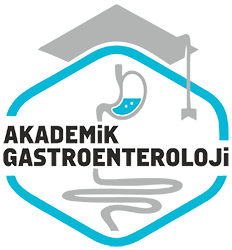Agustos 2017
Primer biliyer kolanjit hastalarinda tedaviye yanit kriterlerinin değerlendirilmesi
Assessment of treatment response criteria of primary biliary cholangitis
- Ana Sayfa
- Sayılar
- Agustos 2017
- Primer biliyer kolanjit hastalarinda tedaviye yanit kriterlerinin değerlendirilmesi ...
2Biruni Üniversitesi Tip Fakültesi, Gastroenteroloji Bilim Dali, Istanbul
3Sakarya Üniversitesi Egitim ve Arastirma Hastanesi, Iç Hastaliklari Klinigi, Sakarya
Özet
Giriş ve Amaç: Primer biliyer kolanjit çogunlukla orta yaş kadınlarin etkilendigi, kronik kolestatik bir karaciger hastalığıdir. Persistan kolestatik karaciger enzim yüksekligi, normal biliyer görüntüleme ve antimitokondrial antikor varligi primer biliyer kolanjit teshisi için gereklidir. Ursodeoksikolik asit tedavisi altındaki bazi hasta gruplarinda hastalığın ilerledigi gösterilmıştır. Biz klinigimizde primer biliyer kolanjit tanısı ile izlenen Hastaların tedavi sonuçlarını vermeyi ve Paris-I ve Paris-II, Toronto ve Barselona kriterlerine göre ursodeoksikolik asit yanitini ön görmede testlerin dogruluk oranlarini göstermeyi amaçladık Gereç ve Yöntem: Yüksek Ihtisas Hastanesi Hepatoloji Bölümü’nde 2000-2010 yıllari arasında primer biliyer kolanjit tanısı alan 82 hasta retrospektif olarak incelendi. Primer biliyer kolanjit tanısı antimitokondrial antikor pozitifiligi, alkalen fosfataz enzim yüksekligi ve/veya biyopsi ile konuldu. En az 2 yıl boyunca ursodeoksikolik asit 13-15 mg/kg/g dozunda alan hastalar çalışmaya alındı Bulgular: Hastalar 3. ay, 6 ay, 1. yıl, 2. yıl, 3. yıl, 4. yıl ve 5. yıl biyokimyasal yanit açısından Barselona, Paris I-II ve Toronto kriterleri açısından değerlendirildi. Tedaviye yaniti ön görmede en basarili test dogruluk oranina göre Paris I (%71.7) olarak hesaplandi. Hastalarimizda tedavi basarisini ön görmekte en basarili diğer testler sırası ile Toronto (%54.6), Barselona (%50.6) ve Paris-II (%47.4) olarak saptandi. Tedavi yanitini ön görmedeki basari tüm testlerde 2 yıldi ve sonrasinda basari oranlari artmakta idi. Sonuç: Ursodeoksikolik asit tedavisi baslanan hastalarda 3. ayda karaciger biyokimya testlerinde iyılesme görülmesine ragmen, ursodeoksikolik asit tedavi yanitini ön görmede kullanılan testlerin dogruluk oranlari 2. yılda artmakta idi. Çalışmamızda tanı testlerinin dogruluk orani düşük idi. Bu nedenle daha genis hasta gruplu çalışmalar yapilip sonuçlarımizin dogrulanmasi gerekmektedir.
Abstract
Background and Aims: Primary biliary cholangitis is a chronic cholestatic liver disease mainly affecting middle- aged women. Persistently elevated cholestatic liver enzymes, normal biliary imaging, and the presence of antimitochondrial antibodies are key elements of the diagnosis. It was demonstrated that the disease can progress under ursodeoxycholic acid treatment. Our aim is to demonstrate the response to treatment of primary biliary cholangitis patients. We also aim to determine the accuracy rate of the Paris-I, Paris-II, Toronto, and Barcelona criteria for predicting ursodeoxycholic acid treatment in primary biliary cholangitis. Materials and Methods: Eighty-two primary biliary cholangitis patients diagnosed between 2000 and 2010 were investigated retrospectively. Only patients who were treated with ursodeoxycholic acid with a daily 13–15 mg/kg dose for at least 2 years were included in the study. The diagnosis of primary biliary cholangitis was made by two of the following criteria: presence of antimitochondrial antibody, elevated cholestatic liver enzymes, and biopsy. Results: Patients’ biochemical parameters at 3, 6, 12, 24, 36, 48, and 60 months using the Paris-I, Paris-II, Toronto, and Barcelona criteria were compared. Paris-I was found to be the best test to predict treatment response (71.7%). Other tests are less successful at predicting treatment response (Toronto: 54.6%, Barcelona: 50.6%, and Paris-II: 47.4%). Beyond the second year of the treatment, the success ratios of tests to predict response to treatment were increased. Conclusion: Although liver biochemical tests are improving in the third month of ursodeoxycholic acid treatment, the accuracy rate of the Paris-I, Paris-II, Toronto, and Barcelona criteria increases after the second year of the treatment. We found low accuracy rates for these tests.



